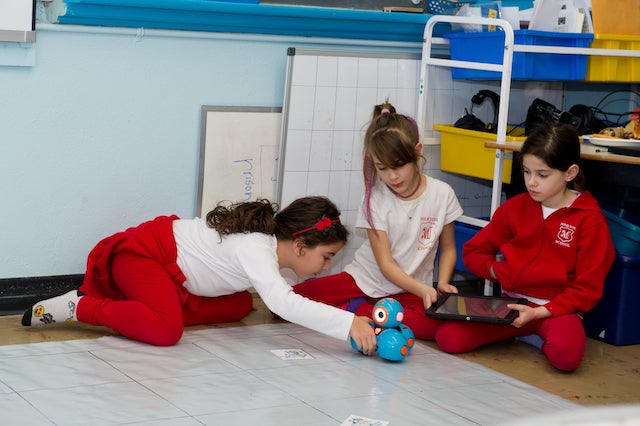Merton School Plays Leading Role in Robotics

When it comes to integrating robotics and computers into an elementary school’s science focus-based curriculum, you can say that Merton Elementary School in Côte Saint-Luc has been a pioneer in that respect.
In fact, students at Merton have been learning the fundamentals of computers and coding, and how to apply them to robotics, for nearly 15 years, and has the distinction of being the longest standing school at the English Montreal School Board (EMSB) to have robotics integrated into their curriculum. It was therefore no wonder that Merton was chosen to host the EMSB’s annual press conference to promote Kindergarten and Elementary School Registration Week, which is scheduled to run from February 5 to 9, 2018. The theme was “Robotics, Coding and Artificial Intelligence – Preparing for the Literacies of Tomorrow.”
“Robotics is one of the centre pieces of our science and technology curriculum,” said Merton Principal Rosana Caplan. “It’s not just for the students to get top marks, it also serves as a catalyst towards developing their interpersonal skills. It helps them work well with others and pull together, whether it be in the classroom or during a robotics competition. And thanks to the STEAM (Science, Technology, Engineering, Arts and Mathematics) program, it has become ingrained in the learning culture here,”
Merton has already been chosen to be one of the seven participating schools to represent the EMSB in the competition phase at the next edition of the prestigious RoboCup International Event and Symposium, which will be held in Montreal from June 15 to 18, 2018.
Ms. Caplan is also proud of the fact that Merton teaches science classes to its students from Kindergarten right through Grade 6. Students from Kindergarten to Grade 2 get science and technology instruction for one period each week, while students in Grades 3 to 6 get two 45-minute periods a week dedicated to the subject. The school uses a wide variety of technological materials, such as digital cameras, green screens, microscopes, Lego building blocks and various robotics equipment.
“The teachers here are very intelligent people who are always pushing themselves by participating in numerous workshops, so that they can learn more about how to teach science and robotics to their students,” said Ms. Caplan. “They are always excited about learning more.”
Ms. Caplan stated that in order to foster even more interest in science and robotics, the school is in the planning stages of renovating its current science room. “We have a floor plan already drawn out, and a fundraising campaign will soon take place,” she said. “Once it’s completed, the new science room will have more space, which will accommodate more laptops and iPads, and will give teachers more flexibility towards integrating science and robotics into the curriculum.”
Debbie Adams, who has been Merton’s science, technology and robotics teacher since 2012, adds: “The whole world is changing, which is why robotics is a major part of the curriculum at Merton and why it’s so important to teach coding to our students starting from their first year in the school. Teaching computers and technology to them at such an early age helps them become more aware of the world around them. It allows them to be more than just users; it allows them to become creators.
For her Kindergarten and Grade 1 classes, Ms. Adams not only teaches students how to code, but also basic computer-related skills like typing and how to use a mouse, as well as the appropriate use of computers and iPads, digital cameras, magnifying glasses and other scientific-related objects. They also participate in a number of building and programming challenges such as LEGO WeDo, and the Wonder Workshop’s online robotics competition.
At the moment, the children have been learning to code using the Scratch Jr. app. This allows them to create animations with a drag and drop type program and teaches them about the sequencing of events. It is a first step to the technology side of AI. They also used Lightbot during the Hour of Code, which is an online game that allows them to collaboratively create code that virtually moves a robot from one place to another.
From Grade 2 onwards, Ms. Adams teaches her students how to use a practical computer app called “Schoology,” which helps them keep track of their homework assignments, and up to date with upcoming events in the school’s monthly calendar. They use this app as a handy, informative resource throughout their school life at Merton.
As well, Cycle Two and Three students engage in hands-on activities once a week that enable them to work as a team to solve STEAM-related problems; Cycle Two students learn about the six simple machines and how to work together to create compound machines using introductory robotics kits, not to mention solving other design challenges; Cycle Three students work together as a team to design, build and program robots using both LEGO NXT Mindstorms and EV3 kits, and this year, the grade 6 students are working with Arduino, Microbits, and e-textiles.
In accordance with the school’s policy of making sure students are aware of the dangers of having unlimited and unsupervised access to technology – especially the internet – Ms. Adams points out during her classes the rules and guidelines on how to use technology and the internet in a safe, responsible manner; for example, she always urges her students to log off any password protected apps when they are in the computer lab.
When it comes to teaching Merton students all the fundamentals of science and technology and integrating robotics into that curriculum, she admires their strong sense of tenacity and determination. “Whether it be coding or building a robot for a class assignment or a competition, the students want to get it to work,” she said. “When they are stuck, often a question asked or a small hint helps them to get beyond their stumbling block by looking at it differently. I believe that it isn’t the end that is important, but rather what they learn along the way.”





